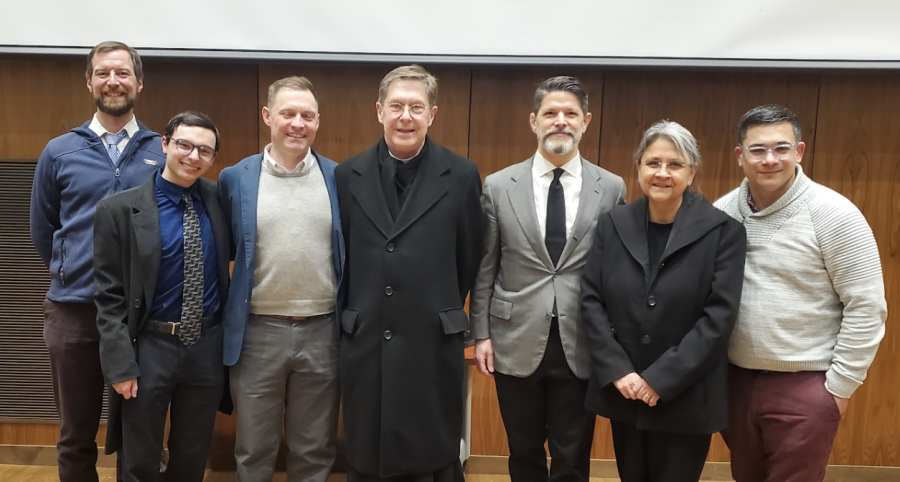Theology speaker lectures on ‘Structures of Virtue and Vice’
Left to right: Prof. Rugani (Theology), Tom Canuel ‘24, Prof. Daly, Fr. Bene- dict Guevin, OSB, Profs. Bidlack, Pilarski, and Ruiz (Theology)
March 9, 2023
Dr. Daniel J. Daly discussed “the Structures of Virtue and Vice” at the spring Theology Colloquium in the Melucci theater the evening of Tuesday, February 28 in what Daly called “the honor of a career.”
Professor Daly graduated from Saint Anselm in 2000. He later taught as a theology professor here for thirteen years, was the department chair for five years, and is now an associate professor of moral theology at Boston College’s School of Theology and Ministry. He has also served on ethics committees at Manchester’s Catholic Medical Center and Elliot Hospital. Professor Daly and the Saint Anselm Theology Department were clearly very excited at the reunion.
“I spent seventeen years of my life here between teaching and as an undergraduate, and it’s one of the most special places in the world for me, so this was one of the biggest honors of my entire career coming back up to give this talk, and I mean that sincerely,” Daly said. “You have no idea how much I was looking forward to seeing so many familiar faces and just being with all of you here at St. A’s.”
Professor Daly’s lecture considered the ways social structures promote both virtue and vice.
“There’s a concept in liberation theology called the structures of sin, and I thought: structures aren’t just sinful, they’re also virtuous,” Professor Daly explained. “I don’t think structures just make us sin, or they just lead us to be vicious; I also think they can help us to be virtuous.”
Professor Daly described the need for structures that are “schools of virtue,” which he connected to St. Benedict’s description of a monastery as a “school for the lord’s service.” He emphasized the need for institutions and confraternities in the Church and in society that teach virtue.
“We need to be intentional about joining a school of virtue. We need help in this,” Daly explained. “Over the past 60 years and especially after the pandemic, we have pulled away from community, and the only way we improve in anything in life is to join a school. If you want to become a better baseball player join a school of baseball. If you want to become a better dancer, join a school of dance. If you want to become a better person, join a school of virtue.”
Professor Daly explained that most structures promote both vice and virtue, such as a sports team promoting friendship among teammates but promoting hatred toward opponents. Daly emphasized that while there can be some purely evil structures that only promote vice, there are no perfect institutions that only promote virtue.
Daly’s lecture was made even more personal to students with his frequent, specific examples using structures on campus, aided by his long connections to the Saint Anselm community.
“I did think that he used some very cool examples, like talking about how even the structures of our own college can play into our perceptions of virtue and vice,” Louis Costanzo ’25 commented.
Daly said the most important experience he had in college was falling in love with his wife, but his time at Saint Anselm was also “the most formative intellectual experience” he’s had.
“I didn’t know what theology was when I enrolled, and then I took the Humanities course and fell in love with it: the world of ideas, the world of the mind, the quest for truth, beauty, and goodness,” Daly recalled.
At the end of the lecture, Professor Daly answered questions from students. He responded to questions about structures of comfort, as well as the vices and virtues of healthcare institutions.
Olivia Halle ‘24 asked about the need for checks and balances on the Catholic confraternity revival Daly proposed. Daly reemphasized that none of these institutions can be perfect.
Joanna Archambault ‘23 asked Daly about moral progress over the past thousand years, and Daly expressed doubt that there had been much compared with technological progress.
Daly’s lecture was well-attended and overall well-received by those who attended. As with many of these kinds of events on campus, many students were drawn by extra credit incentives, but Daly captivated the audience, and students generally said they found it meaningful.
“He had a fantastic lecture really defining vice and virtue in terms of love,” commented James Maloney ’24. “I think that that’s what really stuck with me. How we’re on a really big journey to continue understanding our own vices and improving on our virtues. I think that’s very important for the self. It definitely gives you great insight into what your duty is to try and get more involved to have a critical lens when viewing our problems and things like that.”
Professor Daly’s lecture was based on his recent book, The Structures of Virtue and Vice, published in 2021, which won the 2022 Catholic Media Association Award for best book in Theology and Philosophy. Professor Daly’s book was the result of six years of work, beginning during his time as a Saint Anselm College professor and completed at Boston College.
“It’s my first book, so first books will take a little longer,” Daly said. “You’ve got to be patient when you write a book.”



